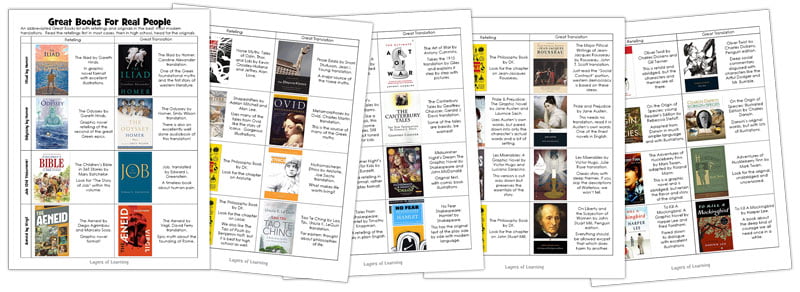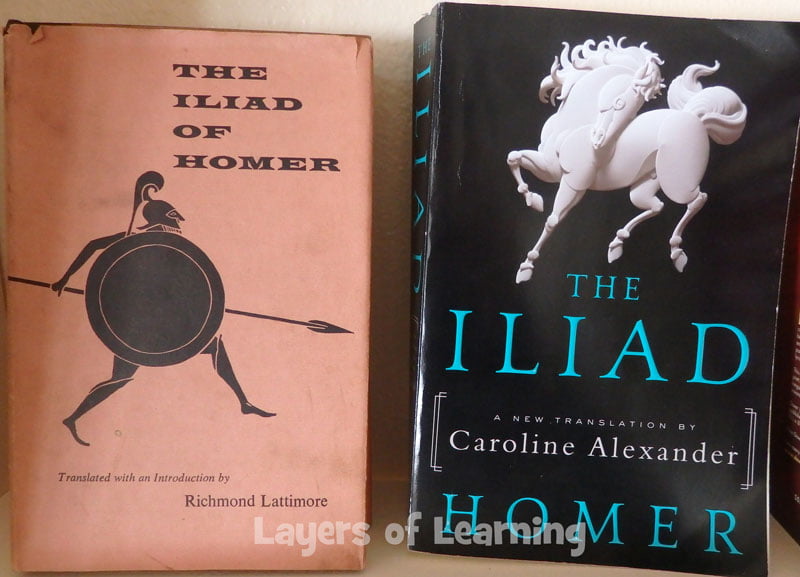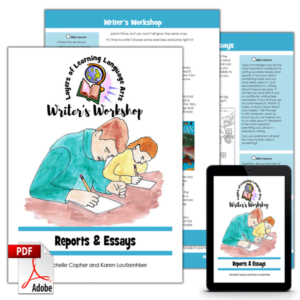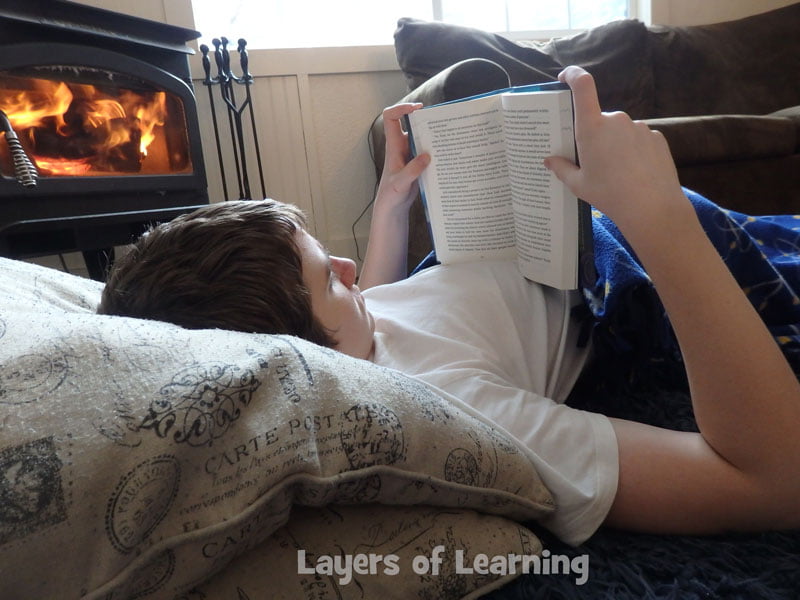If you’ve been homeschooling long, you’ve probably heard about the “Great Books” – the classics that make up the foundations of western civilization and all that. The Great Books are simultaneously valuable and intimidating for most homeschoolers. Here’s how to use Great Books in your homeschool painlessly.
You may enjoy the podcast where Karen and I talk about the Great Books and how to actually read them in your homeschool.
What Are the Great Books?
Great Books are important books, books that have big important ideas like freedom, pain, how to live a good life, justice, and loyalty. They are books that stay in print for hundreds or even thousands of years because they are so enduring and cross cultures and times. The traditional definition includes only books of the western world, basically western Europe and the Mediterranean region. However, I would broaden that definition to take in great works from all over the world.
You can find lists of Great Books on the internet like this one from St. John’s College or the list from this Wikipedia article. But it’s important to understand that all lists like these are arbitrary to some degree. That means you can put whichever Great Books you like on your personal list.
Which Great Books To Add To Your Homeschool?
You only need to read one or two or perhaps three great books a year in your homeschool. The rest of the time you’re reading whatever you like: popular science and history, best selling fiction, whatever. The idea is to introduce your students to deeper more profound thoughts without overwhelming them.
Layers of Learning curriculum includes some Great Books in the reading lists where they fit in history or science or art topics.
And here is a printable of selected Great Books with retellings or children’s versions and the best modern translations available.

Books That Already Appeal
Choose books that have an appeal and won’t be too difficult for your student. For example, if your family has watched the Marvel movies and your kids are into Thor, you could read some of the Norse myths. Your kids will have a compelling reason to be interested in the original because they already love the characters.
The original Norse myths come from The Prose Edda and the Poetic Edda, both written over a period of time in Iceland just before and after Christianization. Both sources are regularly picked to pieces by scholars because of the profound meaning found in the tales so they fit the definition of Great Books.
As Amazon affiliates, the recommended books and products below kick back a tiny percentage of your purchase to us. It doesn’t affect your cost and it helps us run our website. We thank you!
If I wanted to introduce these stories to my children I would begin with a retelling of the tales and I would probably read them aloud to everyone from the six-year-old to the high schooler. Reading aloud makes sure that all, from good readers to less experienced, can enjoy the tales. It also means everyone in the family is at the same place and can discuss the stories together.
I look for engaging storytelling, illustrations, and short chapters in a read-aloud retelling for the whole family. The Norse Myths: Tales of Odin, Thor and Loki by Kevin Crossley-Holland and Jeffrey Alan Love fits perfectly.
Books That Fit With Your Other Learning
You can also choose a book that fits in with what you are already learning in your homeschool. For example, if you are studying the English Renaissance, it’s a perfect time to pick up a Shakespeare play. For a family-friendly option, choose a comedy like A Midsummer Night’s Dream with all its shenanigans, instead of a tragedy. But if you have only middle grades and up, nothing beats Hamlet (just my personal opinion).
This is a graphic version. Original Shakespearean language, without stage directions, just word bubbles above the characters. This is how plays should be read!
Again, choose a retelling first. Read it aloud to everyone. It is important, especially for Shakespeare or anything originally written in English more than a hundred years ago, that you understand the story or text in modern English first. When Shakespeare was written it wasn’t high brow or for the well-heeled. These plays had a general appeal to the everyday commoner of the time. They’re classics because they speak to all of us, but not if the English is archaic. There is nothing dumbed down about retellings or modern translations.
No Fear Shakespeare editions are excellent for this reason. They have the original Shakespearean language and on the facing page the same stuff in modern English. There are also graphic formats out there now, so you can “watch” the play in the pages of a book.
Finally, this is a play. It was meant to be watched, not read. Personally I think reading plays is a bit tedious. Once you’ve read the retelling, watch the play, then if you feel so inclined read the original Shakespearean English. Be warned, not all Shakespeare plays are suitable for children to watch. Check the ratings and preview if you’re not sure! If you are watching a stage play, you should be fine.
- Read a retelling
- Watch the play (at this point, you have this “Great Book” under your belt, check its box)
- Read the original Shakespeare (optional)
If You Only Have Little Ones
If you only have younger kids, say under ten or so, begin with fairy tales and classic children’s literature. Wait for the middle grades for a retelling of the Odyssey and other heavier tomes.
Fairy tales and folk tales from around the world are classic literature. People write doctoral theses on them and yet they are still for children.
Books like The Secret Garden and The Jungle Book are also classics. Just because something is written for children doesn’t mean it doesn’t contain big important ideas. In fact, all good children’s literature does contain the best stuff, just like grown-up literature does.
Usually, these will be read-alouds as well. They are not just for little kids, you can read these to all ages as well. If you have wide ages of kids, mix children’s literature with retellings of more grown-up literature.
Deeper Reading For High School
Your high school student can go on to read the original or a translation of the original text (as opposed to a retelling). A translation stays truer to the original. But, and this is so important, the translation you choose is vital.
A good, modern translation means your student will find the text readable in modern English. This doesn’t necessarily mean it will be easy, but it will be possible, whereas an archaic 18th century translation is difficult just because English has changed so much in the last 300 years.

Some books can just be read, but many on the Great Books list will benefit from a guide. We recommend the SparkNotes guides, because they are thorough and free online.
There are also video guides or lectures on YouTube. Just search for the book you’re reading. Often it is useful to skim the guide before you read or as you read, instead of after.
Finishing With Depth
Book Discussion
We highly recommend that you discuss Great Books. The discussion doesn’t have to be formal, like you remember from school. You can bring it up while doing dishes, driving in the car or sitting around in Grandma’s living room. This not only is less intimidating, but it teaches kids that big ideas and deep discussions can take place in everyday life, not just at school.
If you do want a bit of formality, try a discussion tea time. Pull out the muffins and the tea or cocoa and have a discussion at the table.
Here’s a simple formula to discuss any book or play.
- Start with an easy question, but not a yes or no. Example: Who was your favorite (or most hated) character and why?
- The second question should build off the first. Example: What do you think was (character’s) biggest flaw? Why?
- The third question, if your discussion hasn’t taken on a life of its own by now, should redirect to another deeper aspect. Example: What do you think was the most important message in this book?
Encourage lots of comments and polite disagreements, and different points of view. Never, ever, ask a question with only one right answer. Those are comprehension questions, not discussion questions. They are boring and tend to stifle discussion. It is so important that kids feel free to give their opinions without fear of being “wrong”.
Memorization
Contrary to popular belief, memorization, like picking a poem, play, or book to bits, increases enjoyment. You don’t have to memorize from every book you read, but if a book has an iconic or really impactful passage, commit it to memory. You can have everyone memorize the same passage or let them each pick their own favorite to memorize.
Writing About The Great Books
Writing about your reading is especially important in high school, but it’s useful for children to learn to write about books earlier than that. Often it isn’t until you write something that you truly think about it. Kids should be given freedom to choose which direction to take their writing. The thoughts they have about a Great Book should be their thoughts and not regurgitated thoughts from some other commentary. Though, of course, you can quote other commentators to support your own ideas.
The book discussion can be a good place to begin to form these thoughts. Point out when your student has a good idea that could be taken further in an essay or book report.
You will find the Writer’s Workshop Reports and Essays to be useful if you’re shaky about this kind of writing.
-
 Reports & Essays – PDF$5.99
Reports & Essays – PDF$5.99
Great Books Can Be Painless
Schedule a few great books a year into your homeschool. Start with read aloud retellings, then delve into modern translations of the originals. Finish with book discussions and a writing assignment.
Make sure to choose high interest books to hook your kids into reading great ideas. Reading the Great Books is a life-long experience, not something you get done in high school or even college. So make sure you make it fun.

Get a Free Unit
Choose between the first unit in each Layers of Learning subject to try for free when you sign up for the newsletter.
We never spam and you can cancel your subscription at any time.




